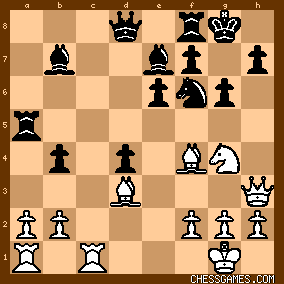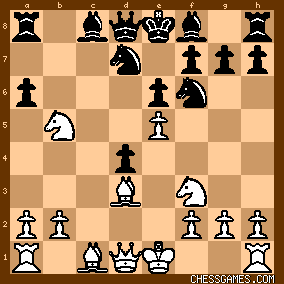|
< Earlier Kibitzing · PAGE 2 OF 2 ·
Later Kibitzing> |
| Jun-26-10 | | DarthStapler: 28. Bh7+ Kxh8 29. Bg6+ Kg8 30. Qh7+ Kf8 31. Qh8# is faster |
|
| Jun-26-10 | | Once: <randomsac: Once again the queen and knight team up for a lethal combination.> Indeed. I read somewhere that some grandmasters have a saying "queen and knight, you'll be alright". Perhaps the queen and knight combine so well because they don't share each others powers, and this allows them to cover more squares for tactics like mating combinations. |
|
Jun-26-10
 | | Jimfromprovidence: Great win by white, with excellent pressure applied to black's position. Black had defensive resources, however, that he did not employ. 17... Bc7, as mentioned by <Mateo> in 2005, looks pretty good for black.

click for larger view
It protects against the knight fork on c6, and if 18 Ng4, then 18...g6 looks good.

click for larger view
White still has the bishop skewer on c6, with a small advantage to work with thereafter. Black also had 19...h5, below, which protects against the devastating text move 20 Ng4.

click for larger view |
|
| Jun-26-10 | | SuperPatzer77: <DarthStapler: 28. Bh7+ Kxh8 29. Bg6+ Kg8 30. Qh7+ Kf8 31. Qh8# is faster> You use the incorrect move number - 28. Bh7+ - the correct move number should be 29. Bh7+. It is mate on the 32nd move below:
Your analysis is as follows:
29. Bh7+ Kxh8, 30. Bg6+ Kg8, 31. Qh7+ Kf8, <32. Qh8#> Mine is as follows:
29. Qh7+ Kf8, 30. Ng6+ Qxg6, 31. Bxg6 any bishop move, <32. Qf7#> It is not faster than mine. It's just the 32nd move of both analyses. Well, it doesn't matter if your analysis is faster than mine. Just a win is a win (period). SuperPatzer77 |
|
| Jun-26-10 | | screwdriver: great game |
|
| Mar-27-11 | | Whitehat1963: How can it both LOOK so simple and be so difficult for Guess the Move? |
|
| Nov-09-11 | | visayanbraindoctor: Going into an ultra-sharp opening like this Meran variation was never Capablanca's common practice. He prepped his opening here. 11. Nxb5

click for larger viewSuch prepared opening sac variations do not occur in the normal Capablanca game. It might be unsurprising in an Alekhine game, or might occur more familiarly with modern GMs who have these prepared variations ready to spring on their opponents (who hopefully did not prepare as well and would get lost quickly in the complications). I would like to know if Capablanca has other similar games in which he sprung a sharp previously prepared opening variation. |
|
| Nov-09-11 | | visayanbraindoctor: Note aside, if Capablanca had been diligent enough to have prepped most of his openings in such razor sharp variations, especially during his earlier years when he could wade through any complications out-calculating every one, what games he could have produced! Just imagine dozens of Capablanca games with razor sharp openings leading to whirlwind attacks just like those of Alekhine or Kasparov's. |
|
Dec-31-11
 | | Peligroso Patzer: <talchess2003: A sharp game would have arisen after:
11. exf6 dxc3 12. fxg7 Bxg7 (12... cxb2 13. gxh8=Q bxa1=Q 14. Qxf8+! Kxf8 15. Ba3+) 13. Qc2 cxb2 and now white will face two appealing prospects of recapture. I would not mind playing white in this position, even though he is a pawn down he has good chances> [from Dec-17-03] The comment quoted above from eight years ago is remarkable for the large number of obvious flaws contained in a short paragraph. <Chessical> has already commented that <13. … Nc5> (in lieu of <13. … cxb2>?) is a big improvement for Black in <talchess2003>’s proposed main line. In addition, in the variation with <12. … cxb2>?, the suggested <14. Qxf8> (annotated with “!” in the original post) probably deserves “??” because after <14. … Nxf8>, White is completely lost. On the other hand, in this line the obvious <14. Qxa1> is totally winning. As far as the whole idea of <11. exf6> is concerned, it is dismissed by theory. According to Opening Explorer, the only example currently in the CG.com database is: E Kursk vs Keres, 1935, 0-1 in 30 moves, even though (as pointed out at page 44 of this thread: Kramnik vs Anand, 2008) Keres did not play the clearly winning <14. … Bxc3+> (with <15. … Bxa1> to follow), presumably due to exaggerated fears of dark-square weaknesses in this line. |
|
| Jul-27-13 | | builttospill: Been thinking about converting to a d4 player, so I'm testing things out on Guess-the-Move. From the looks of it this game has been heavily analyzed. But just in case anyone missed it, I had a strong recollection of a chess puzzle I'd solved from CT-Art as I was playing through. Perhaps not the same exact game, but a very similar theme. On move 22 I saw a very clear mate to follow, as after Nxf6 Bxf6, black does not have the luxury of pushing his f pawn (which would block the light squared bishop -- the reason for Capa's zig-zagging queen moves in the game variation). Anyway, after Qxh6 Re8, Bh7+ wins. (With Bg6+, Qh7+ and Qxf7# to follow. ) More forcing than the game continuation. |
|
| Jul-27-13 | | Calli: builttospill> After 22. Nxf6+!? Black can coolly reply Kg7. So Nxh6 is best. |
|
| Oct-04-13 | | builttospill: <Calli> Sorry I missed your comment. But you are absolutely right, of course. I've been in the habit of calculating forcing lines first, but forgot to look at your line. |
|
| Oct-04-13 | | RookFile: Hard to find a defense after 17. Qh3. White has possibilities of: 1) Nc6
2) a knight move followed by Bc7
3) Bg5 with mating ideas on h7
4) g4 and g5
The one thing black does have is the nominal advantage of an extra pawn. You almost want to play 17....Rxe5 and get it over with, but over course, that is death against Capablanca - you're going to lose any random endgame when he has that kind of advantage. |
|
May-23-14
 | | naresb: There appears to be some refinement needed because multiple probabilities could open up. After 20. Ng4, Black plays 20... Be7, but he could have opted for:-- 20... e5
With this Bc8 pins Ng4-Qh3. Also Ng4 is now under attack by Bc8, Nf6. There are various ways with which both players can react to.
(A) White decides to delay exchange of White Bishop and Black Knight. 20...e5
21. Bh4; h5
22. BxNf6; gxBh6
23. Nh6+; Kh8
24. Nxf7+; RxNf7
25. Qxh6+; Kg8
26. Qh7+; Kf8
27. Qh8+; Ke7
28. Qh5; and white has to struggle to gain superiority.
(B) White decides for immediate exchange of Black Knight with White Bishop. 20...e5
21. BxNf6; gxBf6
22. Nxh6+; Kg7
23. Qh5; Qe7
24. Qg3+; Kf8 and in the absence of dark squared White bishop, White has to struggle to gain command over the situation.
(C) White decides to immediately attack Black King with White Knight. 20... e5
21. Nxh6+; gxNh6
22. Qxh6; Re8
23. BxNf6; Bf8
24. Qh7+ # (1-0) |
|
| Oct-13-18 | | PJs Studio: At first I thought; 21...gxf6? Really? Then I saw the rejoinder 22. Nxh6+! Levinfish was way too good of a player to make that mistake, but by this point I’m sure he was sweating. Another Capablanca brilliancy! |
|
| Oct-13-18 | | thegoodanarchist: If Capablanca worked as hard as Fischer worked at chess, then Alekhine might be just another Keres - a great player who could never win the title. |
|
Oct-13-18
 | | Sally Simpson: ***
Hi thegoodanarchist,
Possibly...but Fischer had Capablanca's games to study and work hard with to help him become a great player. Capablanca was a great gifted player and already a world champion. Whose games was he going to study to improve and where was his motivation. Very few players tipped Alekhine to beat him in 1927. *** |
|
| Oct-13-18 | | Daft1: If 21 BxF6 then 22 Nxh6 g7xh6 23 Qxh6 Re8 24 Bh7 Kh8 25 Bg6 and black is helpless against Qh7 followed by Qf7 |
|
| Oct-13-18 | | thegoodanarchist: <Sally Simpson: ***
Hi thegoodanarchist,
Possibly...but Fischer had Capablanca's games to study and work hard with to help him become a great player. Capablanca was a great gifted player and already a world champion. Whose games was he going to study to improve and where was his motivation. Very few players tipped Alekhine to beat him in 1927.> Well, if he were as good as he claimed to be ("I know it!"), there was the field of opening preparation. It was wide open to him. How many variations <could have> been named "The Capablanca Variation"? |
|
| Oct-13-18 | | cormier: Opening Explorer |
|
| Oct-13-18 | | cormier: and then ... Opening Explorer |
|
Oct-13-18
 | | FSR: This last round win enabled Capablanca to finish Moscow (1935) only half a point behind Lasker, and a point behind the joint winners Botvinnik and Flohr. |
|
| Mar-07-24 | | Mathematicar: This game shows that thesis "Capablanca didn't study opening theory" is completely false. On the contrary, his at that time excellent knowledge of opening theory, got even better on the eve of the match with Lasker. All in all, after 1920 his understanding of theory was one of the finest in the world for next 20 years. |
|
Mar-07-24
 | | Sally Simpson: Max Euwe on Capablanca.
"Capablanca did not apply himself to opening theory (in which he never therefore achieved much), but delved deeply into the study of end-games and other simple positions which respond to technique rather than to imagination." https://www.azquotes.com/picture-qu... A wee bit off key I'm thinking. Capablanca's game ooze with imagination and visualization and the technique which is now taken for granted by all good players, a lot of it was learnt from Capablanca's games. |
|
| Mar-08-24 | | Mathematicar: <Sally Simpson>, indeed. In his prime, Capablanca was just so much better than anyone else, excluding Lasker and Rubinstein, that he didn't need cheap tricks. 82 years without him. May he reast in peace. |
|
 |
|
< Earlier Kibitzing · PAGE 2 OF 2 ·
Later Kibitzing> |





